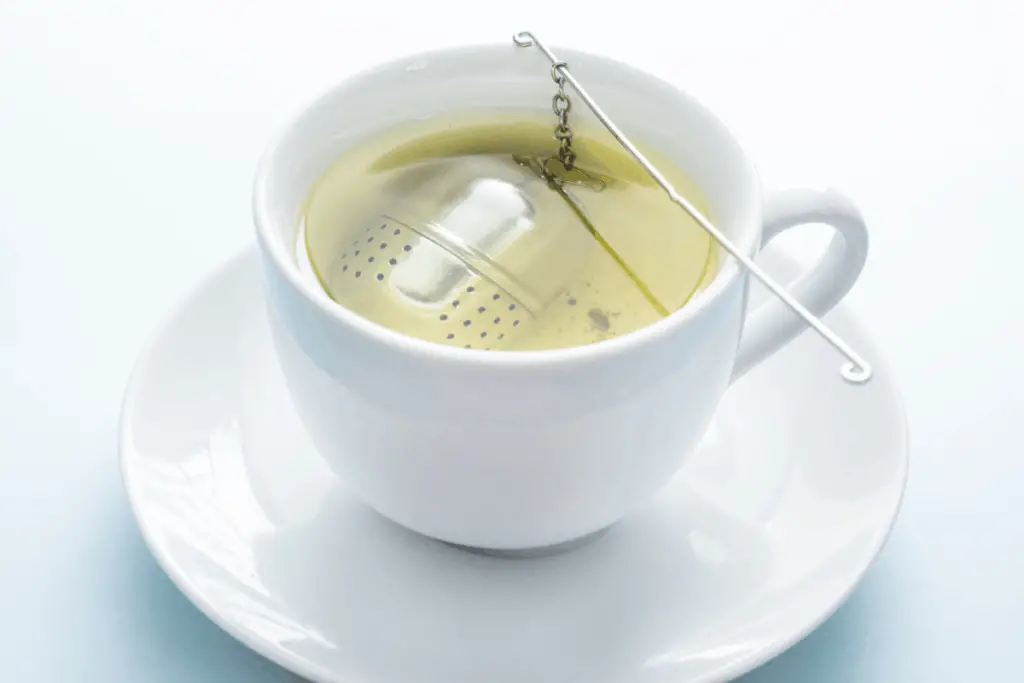Green tea is among the most popular types of tea worldwide. I have been drinking green tea for years and have grown to love the flavor. However, sometimes you might brew a cup of green tea and find it very bitter or sour, believing that it’s just how it should be. But what is it really supposed to taste like if it is made properly? Should green tea taste bitter?
Very bitter or sour tasting green tea is usually caused by using low quality tea leaves, brewing too long, or brewing at too high a temperature. Green tea is usually described as tasting grassy, earthy, nutty, and slightly sweet. It can also taste floral, fruity, and smoky.
Green tea is actually one of the hardest types of tea to brew properly. The resulting flavor depends on many factors, including the quality of tea and how exactly steep it.
Knowing all of this is the key to enjoying it, so I’ll show you how to select a green tea you’ll enjoy and then how steep it properly.
What Does a Properly Brewed Cup of Green Tea Taste Like?
There are many green teas to choose from and their unique flavor depends on how the tea leaves were picked and prepared.
For example, unlike black tea, which is allowed to oxidize. Green teas from around the world result from tea leaves that are picked while still young and shielded from the oxidation process.
According to Healthline.com:
“Both green and black tea are made from the leaves of the Camellia sinensis plant
The key difference between the two is that black tea is oxidized and green tea is not.
To make black tea, the leaves are first rolled and then exposed to air to trigger the oxidation process. This reaction causes the leaves to turn dark brown and allows the flavors to heighten and intensify
On the other hand, green tea is processed to prevent oxidation and thus much lighter in color than black tea.”
In general, green teas usually taste very earthy and grassy. Depending on where it was grown and cultivated, green tea can also taste:
- Sweet, or bittersweet
- Nutty
- Floral
- Fruity
- Marine (Oceanic, like a seaweed might taste)
Is Bitterness a Sign of Bad Tea?
Keep in mind that green tea is always going to taste a little bitter.
During the brewing process, certain compounds are released from the leaves into the water. These compounds include:
- Tannins
- Catechins
- Chlorophyll
All of these will give the tea a slightly bitter note.
But what if your tea tastes too bitter? Well, that usually is a combination of two things.
- Using low quality tea
- Brewing with water that is too hot
We are all familiar with the boxed tea bags from big name brands. They are very inexpensive, easy to use, and easily available. Unfortunately, they generally contain very low-quality tea leaves. This helps keep the cost down, but ultimately leads to lower quality cups of tea and a disappointing experience.
“Green tea is harvested from the Camellia sinensis plant, then quickly heated and dried to prevent oxidation.”
TEA CROSSING
Tips For Better-Tasting Green Tea (How to Make it Less Bitter)
The tea leaves used in most bagged tea aren’t actually leaves at all—or rather, not whole leaves.
Athough there may be some debate about this, it seems that much like hot dogs are made from scraps of better-quality meat, teabags may often be filled with scraps from higher quality leaves.
According to CupandLeaf.com:
“Tea bags are stuffed with the dust and fannings of tea leaves. These broken pieces can develop bitter flavors more quickly than loose leaves or tea powders.”
Even though there may be some conflicting beliefs about the quality of tea bag teas, purchasing higher quality tea will always result in a better-tasting result.

Two essential tips will start you on a better path to less bitter green tea:
Tip #1 Start with a High Quality Green Tea
Depending on where you live, you might even be able to find loose leaf tea in your local supermarket.
Other places to find good loose-leaf tea include:
- Local tea shops
- Organic grocery stores
- Imported food markets
- Online—many good tea vendors will ship right to your door!
Don’t forget that you’ll need a tea infuser to brew your loose-leaf tea! You can find wide variety of infusers to suit your preferences and needs.

Tip #2: Steep With Cooler Water and For Less Time
Brewing tea with water that is boiling hot is not good for the leaves. Higher temperatures of water cause an excess of unwanted bitter compounds to release during brewing, which is what leads to the overwhelming bitter taste.
A temperature-controlled kettle can heat the water to exactly the right spot (about 170 F). You can also use a thermometer to check the water temperature. If you don’t have either of these options available, you can either heat water to just short of boiling, or alternatively, boil water and then simply let it cool down.
In addition, green tea leaves should not be steeped for too long. Even with good quality teas, steeping for too long in hot water will produce bitterness. Green tea generally should only steep for between 1-3 minutes.
Steps For Making the Best Cup of Green Tea
Made properly, a cup of green tea should taste light, grassy, and bittersweet. Depending on the where the tea was grown and cultivated, it could even taste nutty, fruity, floral, or even slightly fishy.
As mentioned above, water temperature and steeping time also play a large role in the resulting flavor.
Steep Green Tea at Lower Temperature
There are some difference between Japanese and Chinese green teas and they both benefit from slightly different steeping temperatures as well.
Traditionally, Japanese green teas and spring teas are brewed at lower temperatures (160°F to 170°F) and standard Chinese green teas at higher temperatures (170°F to 180°F).
Steps for Steeping Green Tea

To make your green tea taste the best it can:
- Use high-quality, loose-leaf tea leaves.
- Don’t use boiling water. Let the water cool 1-2 minutes before adding the leaves.
- Brew for 1-3 minutes depending on how strong you like your tea.
How Do Types of Green Tea Differ, and Why?
Tea leaves have a long journey before they find their way to your pantry. Making tea is one of the oldest human pastimes. Much like wine (another one of the oldest drinks), there are as many ways to prepare tea leaves as there are people to drink them.
Believe it or not, white, green, and black teas are all made from the leaves of the same plant, Camellia sinensis.
The differences among the three teas result from when they are harvested, how long they are allowed to oxidize, and how they are processed.
The leaves for green tea are picked while they are still young, which contributes to their fresh “green” taste.
Once the leaves are picked, they are then processed. There are two primary methods for doing this and both result in a different tasting tea.
Japanese Processing Method
The Japanese method of processing tea leaves uses steam to help extract the flavors.
Compared to Chinese green tea, Japanese green tea:
- Is a brighter color of green
- Is usually sweeter
- Has a “grassier” taste
Matcha is also a type of Japanese green tea that has gained a lot of popularity in the western world. Instead of allowing tea leaves to steep in water, matcha is made with specially grown leaves which are then ground to a fine powder and mixed directly into hot water.
Matcha is usually a little more bitter and “buttery” compared to a normal Japanese green tea.
Chinese Processing Method
The Chinese method of producing green tea is actually to sear the leaves in a pan—but only for a few seconds! This brings out their flavor in a different way than steaming them. They might also be dried in the sun.
According to CoffeandTeaCorner.com:
“This makes the leaves a duller green color, and in turn they produce a yellowish brew, rather than a greenish one.”
Compared to Japanese green tea, Chinese green tea is typically:
- Nuttier
- More bitter
- Occasionally “smoky” in flavor
Ultimately, the type of green tea you choose just depends on your palate. Experiment with different types of high quality green teas and see what you prefer.
What are Some Food Pairings for Green Tea?
It can be an interesting process of discovery and experimentation to find which green tea pairs well with the foods you enjoy.
In addition to experimenting with pairings yourself, you could look to a few time-tested combinations.
When is comes to pairings, much of the work has already been done for you. Because tea is so culturally important to many Eastern Asian cultures, there are already types of teas produced specifically to be enjoyed along certain dishes.

Here are some suggested pairing options:
- Genmaicha is usually described as hitting similar taste notes to coffee, so it can pair well with breakfast pastries.
- Sencha is a type of Japanese green tea that pairs well with sushi because it is so refreshing.
- Matcha is a very rich and buttery green tea, so it can go toe-to-toe with other strong flavors like barbequed meat!
- Much like Matcha, many Chinese green teas can pair well with rich meats due to how their bitterness can bite through rich flavors.
In addition to being healthy for you, green tea can open up a new world of exploration into loose leaf tea, steeping practices, and food pairings.
Now you’re ready to discover the delicious world of green tea!

